The 382 units of cooperative housing known as “Freedom West” were built in the mid-1970s, with 10 buildings rising up to 35 feet in height across four city blocks that were bulldozed under the guise of an “urban renewal” of the Fillmore District, led by the San Francisco Redevelopment Agency, in the 1960s.
Having been underfunded over the past 50 years and on the brink of failure, plans to raze Freedom West have been drafted.
And as proposed by McFarlane Partners, in conjunction with the Freedom West Homes Corporation and Legacy First Partners, which is led by a former Freedom West resident, over 2,300 units of housing and a 150-room hotel would rise across the 10.8-acre site bounded by Golden Gate Avenue, Laguna, Fulton and Gough Street, with multiple mid-rise buildings and six towers rising up to 345 feet in height.
In addition to 382 replacement units for the current residents of Freedom West, the redevelopment as envisioned would yield another 133 units of affordable housing and 1,790 market-rate apartments distributed across the project site, with off-street parking for 1,854 cars; ground floor community, maker and retail spaces; and an Innovation Center (“providing STEM workforce and entrepreneurship skills training and small business assistance services”) along Golden Gate Avenue.
But the site is primarily only zoned for development up to 40 feet in height, with 50 feet in height allowed along Gough.
And as such, the development team is positioning for the approval of a Special Use District (SUD) and rezoning of the site, with a height limit of 85 feet for the majority of the site, 105 feet for the hotel at Fulton and Octavia and spot zoning for the six towers, ranging from 150 feet to 345 feet in height, as massed above and from a few different perspectives below.
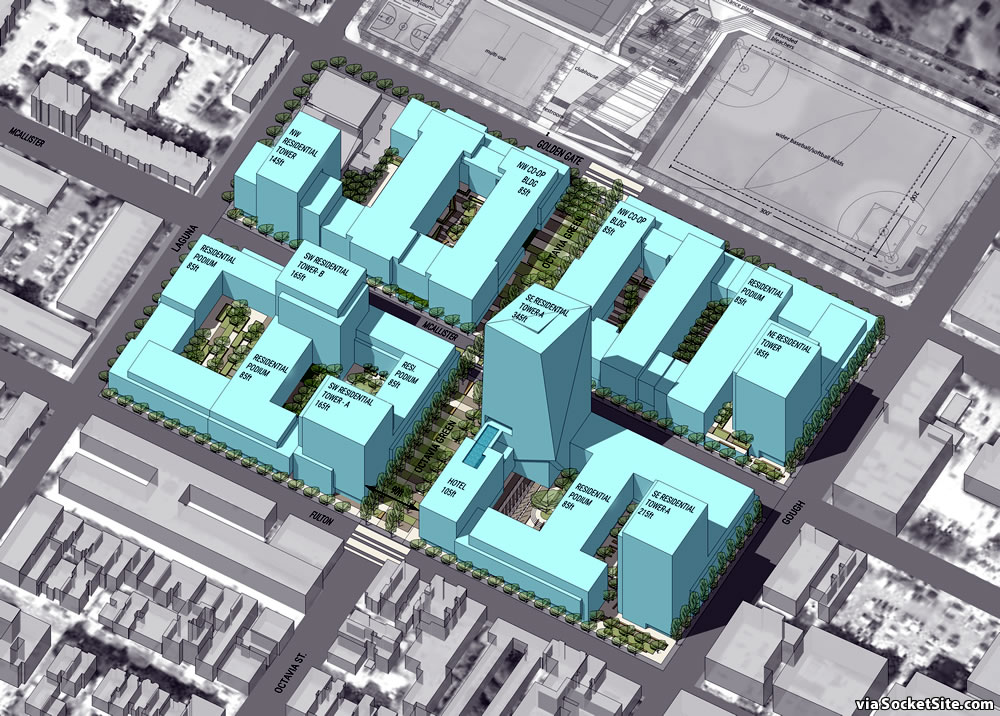
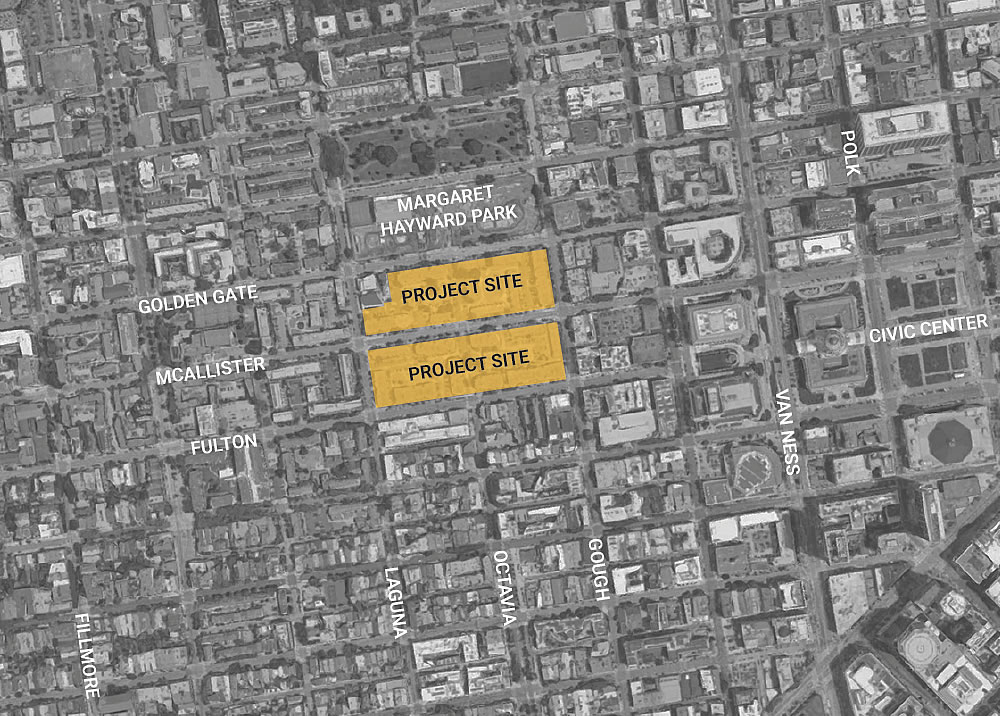
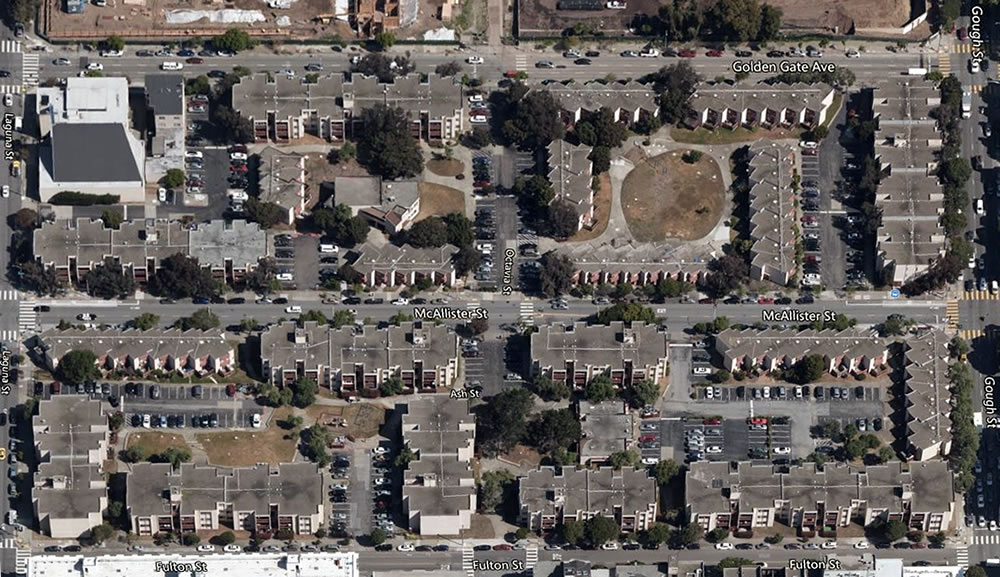
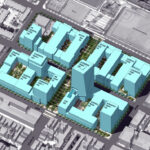

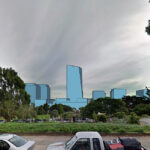
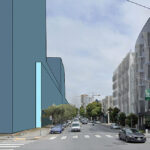
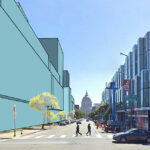
This is a very ambitious plan, and should be built. Will it be built?
And please, please cut the parking out of this transit rich area. Why nearly 1900 parking spaces? This suggests that this will generate a lot of auto trips to this neighborhood, which is already traffic clogged.
1900 new parking spaces is abhorrent in a transit-first city. This should be limited to, at most, replacement of any existing parking spaces. I wonder if the developers wanted them, or if it just seems like city planning codes would require them.
agree the plan is great for housing, but terrible parking ratio. this should be 200 spaces tops. thats a pretty transit friendly place and very centered
There is no parking required for any use in any part of San Francisco anymore. The Board legislated that a couple years ago. So the answer is the developer wants them.
I’ve been waiting for this city to become transit-first in more than name for 20 years and I’ll likely wait another 20. Garage spaces can and should kill off curbside parking, and both Golden Gate and Gough are designated traffic sewers. If ever a plot of land deserved to be a honeypot for parking it’d be this.
The mistake maurice, you and Jeffrey W. Baker are making is assuming that if parking is made difficult by planning policy, people will use transit instead of private automobiles. That isn’t the case.
20 years ago, you didn’t have Uber and Lyft. Now, unfortunately, we do. So eliminating parking just creates more demand for the illegal cab services, and contributes to the traffic clogged streets, increasing the travel times for everyone. If there is no available curbside parking, the drivers just let people out in red zones, and if they can’t find space there, their passengers just get out anywhere they feel like.
I read these comments from people like jimbo and think he must be an Uber stockholder.
Since when is SF a transit-first city? Have you actually relied on Muni as a primary transportation source? I’m all for public transit, but it’s not a viable means of transportation in SF, nor will it be for at least a couple of decades.
I will likely not be for me for the rest of my life. I used to be a frequent Muni rider–bought a monthly pass every month. But I haven’t been on a transit vehicle since last March and don’t expect to be on one again. COVID was the last straw but I had been riding less and less for some time as fare evasion by misbehaving and unwashed fellow passengers increased. Muni became anarchic as well as inefficient and unreliable. Thank G*d for Uber/Lyft I say–without them I’d be buying my own car once again and I hope to avoid that but I’ll do it if the city forces me to.
Since 1973, and reaffirmed by voters in 1999, 2007 and 2014.
Did everyone miss the part about retail/community space/hotel? Underground parking is essential for a project like this to ensure these businesses can attract customers and keep traffic moving (vs folks double parking along these transit rich streets). Also, with all of the parklets for outdoor dining (which hopefully survive in a post-COVID world), it’s essential to build parking in services rich neighborhoods like this one.
Maybe instead of being anti-parking, the city should restrict residential parking.
The parking as proposed includes 1,728 spaces for the residential units, 116 spaces for the commercial tenants and 10 spaces for the hotel. An additional 16 spaces for a car sharing program are envisioned as well.
i agree the parking is excessive. but building parking is all about efficiency of scale. these two full blocks allow for massive underground parking, possibly connected under McAllister. i can understand why the developer wouldn’t want to leave that money on the table.
Who allocates the contracts and collects the revenues?
Would this be a city-owned majority-market rate project?
Unusual, I think, no?
This project is being pitched to the current owners of the Freedom West CO-OP who own the land. What’s 4 blocks of this part of SF worth? I have no idea but it’s likely quite a few millions and these mostly lower income people will really cash in if this happens. No it won’t be “city owned”. Surely it will be market rate with the usual required percentage of “affordable” units and also with replacement units for the current Freedom West co-op members. What isn’t clear is whether they will still own the project or perhaps some percentage, sharing ownership with McFarlane.
They should kill off curbside parking. I made this argument aggressively to the powers that be regarding The Hub project. Bottom line is that they want both, every single inch of curbside parking they can get plus as many garage spaces as the public will approve. They want big dollars for those units and people with money want parking. That is considered important for financing the project to begin with. Their main transportation plans all stress freeway access.
Do I misunderstand or are you anti-curbside parking? I haven’t owned a car in 20 years but curbside parking makes sidewalks exponentially safer for pedestrians.
I don’t know about that, but curbside parking does make the roadway exponentially more dangerous for people on bikes.
Depends on what you replace it with. Replace it with additional traffic lanes to turn the street into a mini-freeway, as was done in many places, and yes it’s more dangerous. Eliminate it as part of a road diet, on the other hand, where you use the extra space to add pedestrian amenities, trees, etc, and it’s not.
Smack across the street from Nuru estates. How ironic. And yes, thank the father on high the privileged & infamously preachy white architect once again mansplains to the working class folks of the Fillmore about what is on-trend for how they must live, a la Justin Herman: “I may expect you to come over and nurse my elderly parent, but don’t you dare expect to park your car at home! Take the bus!”
i definitely agree with your sentiment. but those redevelopment monsters definitely have a parking ratio well over 1:1. what was there before redevelopment before probably did not – it was all built before cars. the white man preached cars, and parking, were the key to “equity” — that was the lie.
So we rebuild housing every 50 years? Think about the absolute waste that building 4 city blocks every 50 years does to both the environment, material resources, and where do all those people live while this is being built? I’m all for more housing but is this in such bad shape that it can’t be rehabilitated for much less cost?
It’s privately owned by the co-op owners who live there so that’ll be up to them.
Transit oriented ? Ha Ha, Muni is toxic ! No one, but those with no other options, will ever use MUNI again! Research has found that riding transit in flu season can increase your risk of catching an acute respiratory infection as much as six-fold.
Agreed on the transit oriented part. It’s hardly a transit-rich area. Anyone who thinks SF is a transit-first city needs to get woke.
In 2001 I bought a second home in the desert of southern AZ and started spending my winters there. When I was in SF during the winter and regularly riding Muni I averaged about 3 bad colds or flu per winter. Since I ceased that behavior I can’t recall having a winter cold. COVID has also taught me a lesson. I suspect mask-wearing may become a life-long habit for me, especially in crowded public environments including transit, summer OR winter.
From this rider’s perspective, Muni is now cleaner and more reliable than ever.
Wow, what a positive move!
Is more density possible?
The destruction of the Western Addition during the urban renewal years left this very central part of town without the character and street life it had before, and most crucially reduced in density in a way that no longer makes sense.
I have long felt that these blocks were ripe for building up. The key is proceeding in a way that provides continuing and increased equity for existing residents to avoid the displacement that took place the first time around.
Perhaps if this plan is successful it will inspire more projects like it in the surrounding blocks.
Not necessarily in terms of ownership and management model for this project, but I look to the Potrero Annex and Terrace and Sunnydale redevelopments plans as good examples of a couple things. 1) How mid century lower income housing can be densified and economically diversified while 2) being phased and structured in a way that nearly eliminates displacement of current residents, 3) brings additional BMR units online, AND 4) adds a substantial amount of market rate housing.
A plugged-in reader would know something similar has been done before, just a couple blocks away…
I’m just glad they are going to right the wrong of Octavia being turned into private parking lots. Gimme that landscaped pedestrian walkway!!
UPDATE: Planning’s Preliminary Support for a Towering Freedom West 2.0
I wonder what’s going to happen to current residents when they’re displaced, homeless & for how long. I still have family in freedom west. Man, these investor groups & robber barron RE developer been licking their chops decades to take over freedom west & tear it down to build a high rise. Gentrification f*cked up my neighborhood & the whole city.